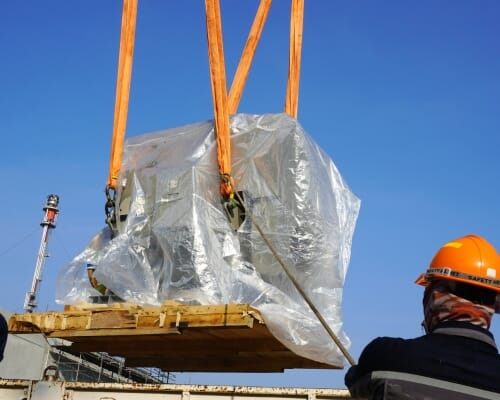
Signs Your Air Compressor Needs Repair or Replacement
October 30, 2024
CFM vs. PSI: What You Need to Know to Size an Air Compressor
November 13, 2024The Impact of Temperature on Air Compressor Efficiency
Kaishan USA | November 6, 2024| Uncategorized
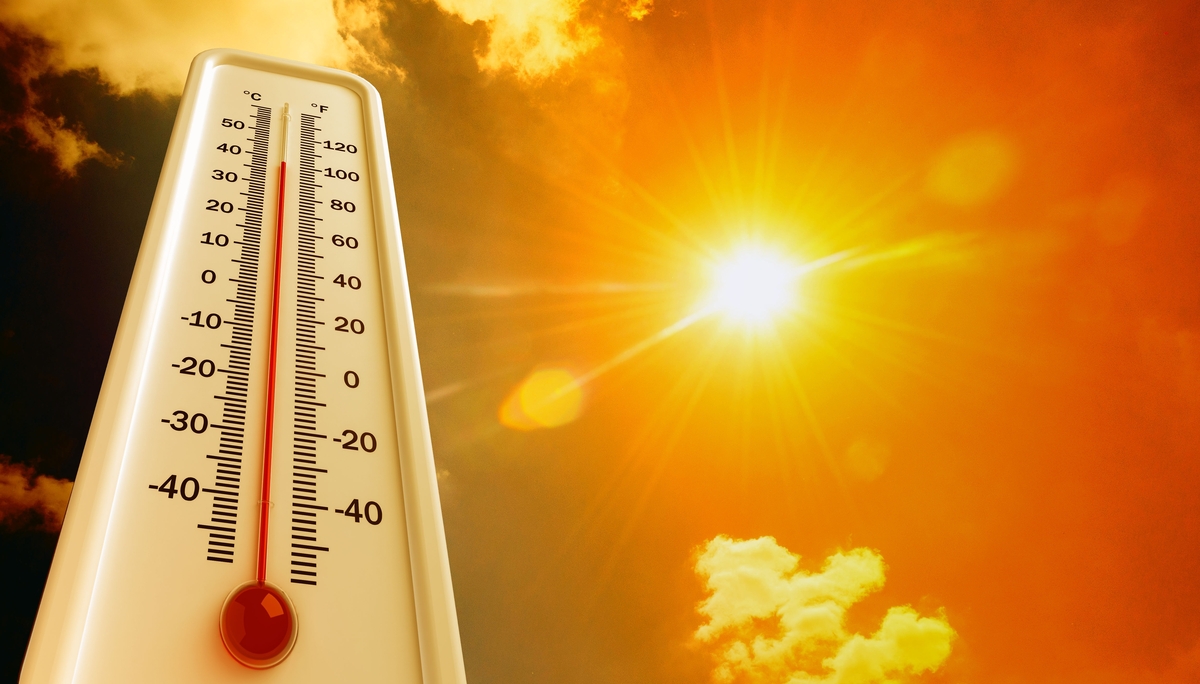
Outdoor temperatures of 100°F air (or higher) make your air compressor struggle. And that spells trouble for air compressor performance.
Elevated outdoor temperatures can have a significant, negative impact on air compressor efficiency.
If it’s already hot outside, that heat will have to be removed, or your compressed air system efficiency will suffer. You can’t cool things off with hot air.
And while it may not be hot outside right now, heat is an issue you will want to keep in mind as you are doing updates on your system (usually in winter months). And as you’ll see below, not all heat problems come from the outside.
The Heat Comes On
There are two ways heat enters your compressed air system.
First, the temperature of the outside air you draw into your compressor brings outdoor temperature inside. If it’s 100°F outside, all that heat comes right into your unit. And you’re starting out behind the eight ball.
Second, during the compression process, your compressor generates heat as a part of normal operations. It’s called the heat of compression, and it occurs naturally as the air molecules are jammed closer together. The higher the ratio between the discharge and suction pressure, the more heat you generate. Plus, the faster your compressor operates, the more heat it produces.
The ambient air that enters your system, presumably at 70°F, will reach 175°F-200°F in an oil-lubricated screw compressor, according to Air Compressor Guide. You’ll need cooling and drying equipment to condition that air down to a more manageable level. However, it will still be 10°-20°F higher than your incoming air. We call this difference the approach temperature.
As a result, if your intake air is at 110°F, you will struggle to get the compressed air you send downstream below 120°-130°F.
And that will kill a lot of equipment throughout your compressed air system. Those high compressed air temperatures will:
- Shorten the life of the oil and the compressor itself. For every 10°F you operate the compressor above its normal operating temperature, the oil life is cut in half.
- Increase all your costs, including electricity bills and maintenance expenses.
- Produce poor air quality, including pass-through of oil and water.
- Damage end-use tools and equipment, degrading lubricants and seal materials.
- Cause corrosion and scale buildup and may even result in freezing in colder climates, as the water vapor in hot air is released.
That negative impact will produce ripple effects throughout your system.
Ripple Effects Downstream
Excess heat will make a dryer work much harder. And if the dryer’s not working, filtration will not work properly either.
So, you will be sending water and other contaminants into your end-use equipment. That’s going to cause problems with applications, like painting, that require high-quality compressed air. And it will ultimately damage some end-use tools.
In the case of applications where there is direct contact with products, those products could be contaminated.
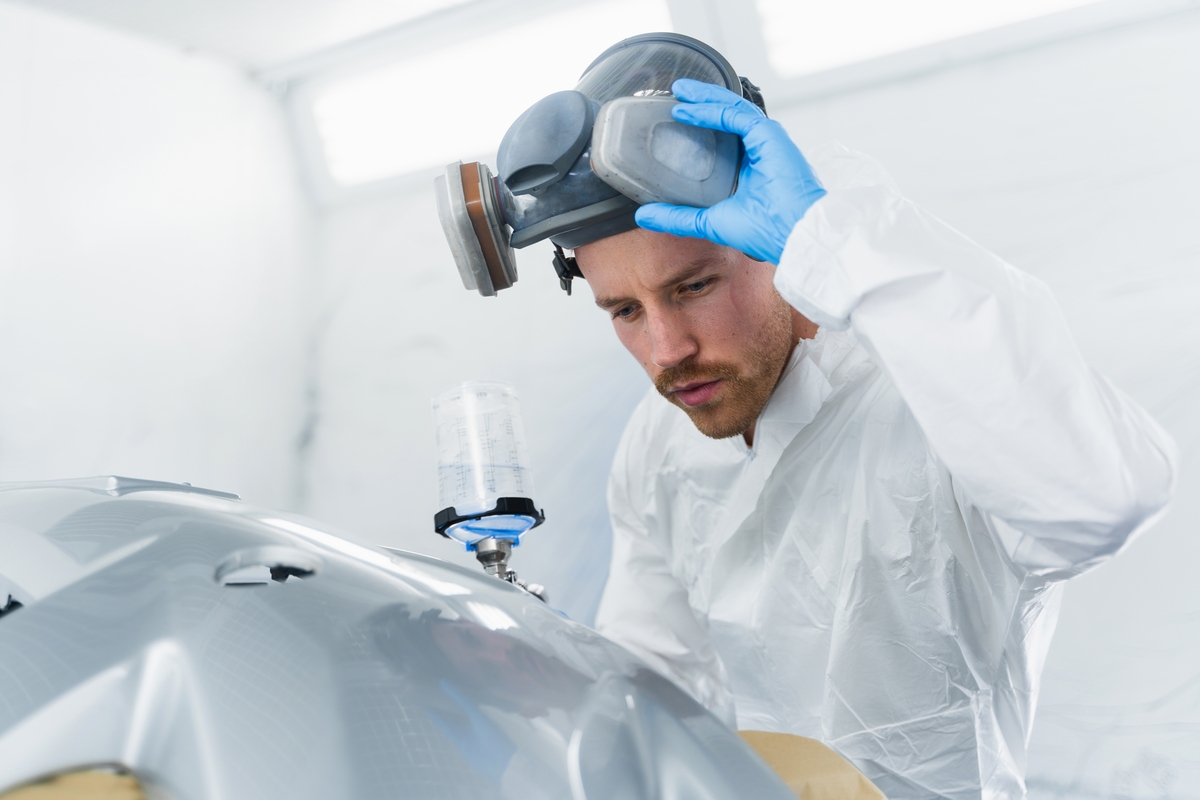
High temperatures are one likely cause of the top complaints we get from painting operations concerning moisture and impurities in their compressed air supply.
One of the top complaints we receive from paint shops, for instance, is the water, oil and other particles in the air flow that causes fisheyes and other imperfections in the otherwise flawless surface the shop’s customers expect. (There are other causes of contamination, of course, such as undersized filtration and drying equipment, lack of maintenance and poor environments.)
However, realistically, most air filtration and treatment systems are not designed to take a lot of heat. So, once again, if the incoming air is in the triple digits, keeping temperatures under control will be a challenge.
How Most Compressors Deal with Heat
Air compressors used in most industrial applications are oil-flooded, helping them dissipate that heat.
Oil-flooded rotary screw air compressors use a fine mist of oil to keep the compressor’s airend from overheating. The cool oil is injected into the compressor to keep the discharge temperature down. (To see a video showing how our oil-flooded unit uses oil for cooling, visit our KRSP2 page.
As a result, we consider oil to be the lifeblood of your compressor, removing heat and impurities from the compressed air flow. We recommend changing your compressed air system’s oil separator and lubricant every year (or 8,000 hours of operation) or as per machine guidelines. And we recommend that you sample oil every 2,000 hours or 1,000 hours for food-grade lubricant. (For more on oil selection, maintenance and sampling, read our blog post, “Choosing the Right Rotary Compressor Oil”).
However, not all applications can use oil-flooded air compressors.
The Special Heating Challenge for Oil-Free Compressors
There are many applications like food and beverage, healthcare, medical, electronics and semiconductor where even that small amount of oil would contaminate or ruin end products. As a result, these industries require oil-free air compressors.
Oil-free units do not use oil as a cooling agent (although gear oil floods the jackets in the airend to help cool the discharge air and keep the housing temperatures lower).
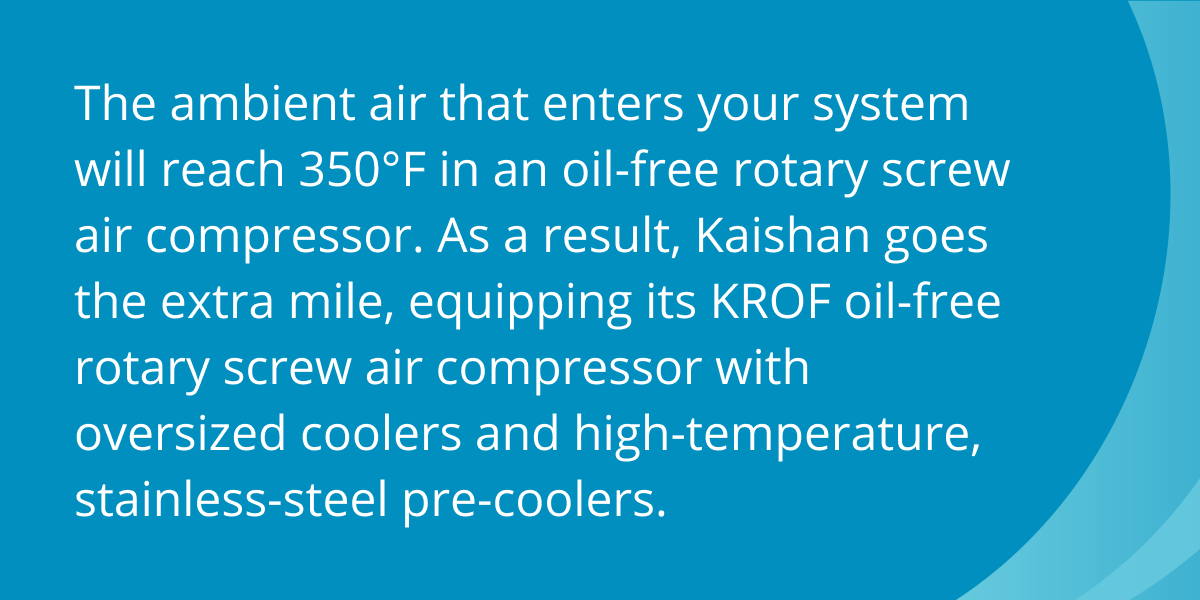
That makes airend cooling even more of a challenge for oil-free units. The ambient air that enters your system will reach 350°F in an oil-free rotary screw air compressor. As a result, Kaishan goes the extra mile, equipping its KROF two-stage oil-free rotary screw air compressor
with oversized coolers and high-temperature, stainless-steel pre-coolers.
Removing the Heat
There are several ways to get rid of that heat, including ventilation, forced air and water cooling.
Ventilation
Ventilation is one of the most critical considerations for the operation and longevity of your compressed air equipment. The goal is to remove all that heat generated during compression and keep it from recirculating back into the room.
There are several different ways to ensure your compressor is ventilated, including louvered vents and forced ventilation. For more information on best practices for ventilation, see our blog post, “Air Compressor Cooling.”
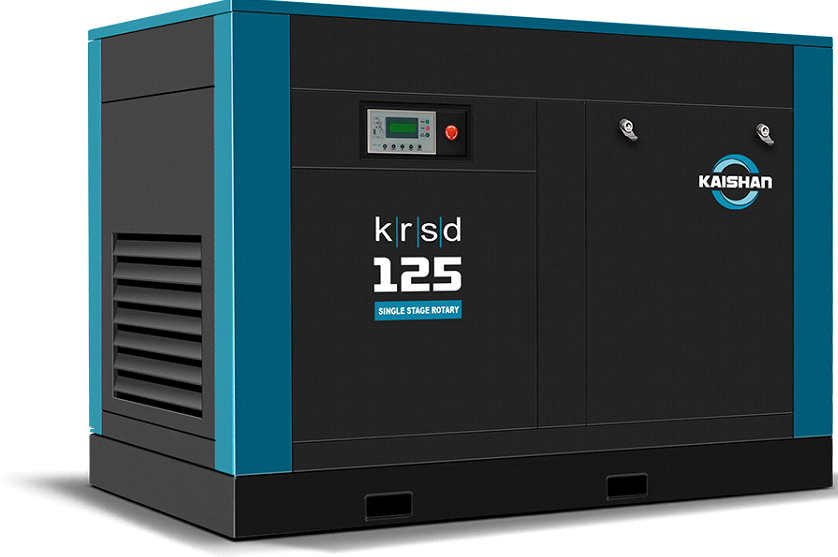
All Kaishan rotary screw air compressors have forced air cooling, including our KRSD direct-drive rotary screw air compressors, which employ an axial fan.
Forced Air Cooling
Compressors larger than 25 HP usually require forced ventilation. An axial or centrifugal fan draws in ambient air and passes it over a heat exchanger to extract the heat, thus cooling the compressor.
All Kaishan rotary screw air compressors have forced air cooling. Our KRSB belt-drive and KRSD direct-drive rotary screw air compressors employ an axial fan, while our KRSP and KRSP2 premium rotary screw air compressors use a centrifugal fan.
Water Cooling
Water can also be substituted as a cooling medium instead of air. In a water-cooled compressor, a pump moves water through tubing around the compressor body, extracting the heat. The water then goes to a radiator, usually a shell and tube heat exchanger, to cool. Water cooling is more common in larger units (more than 300 HP).
Maintenance
No matter which cooling methods you use, you’ll need to adopt good maintenance practices to keep your system functioning properly. We encourage all our customers to develop several different levels of maintenance:
- Regular cleaning and inspection of filters and drain traps, removing any obstructions or replacing clogged filters.
- Oil sampling, ensuring your oil has the remaining life to keep the compressor properly lubricated, thus reducing operating temperature.
- Preventive maintenance, doing routine procedures like oil changes and filter replacements on a regular schedule.
- Predictive maintenance, closely monitoring data from sensors located throughout your compressed air system and taking action to deal with problems before they become serious.
Good maintenance, after all, is preferable to unplanned shutdowns, which can result in lost production time and ruined processes and materials. You may have to schedule a planned shutdown to address the issues in a comprehensive way. And while no one likes a planned shutdown, it’s much better than the unplanned kind.
For more information on preventive and predictive maintenance, see our blog post, “The Differences Between Air Compressor Preventive Maintenance and Predictive Maintenance. And Why You Should Care.”.
Beating the Heat Is a Team Effort
The larger (and more critical) your compressed air system, the more you will benefit from having a compressed air consultant’s advice and assistance. From sizing ductwork to helping you set up good maintenance practices, a professional’s advice can help you deal with heat problems that could otherwise damage your equipment or even cause unplanned downtime.
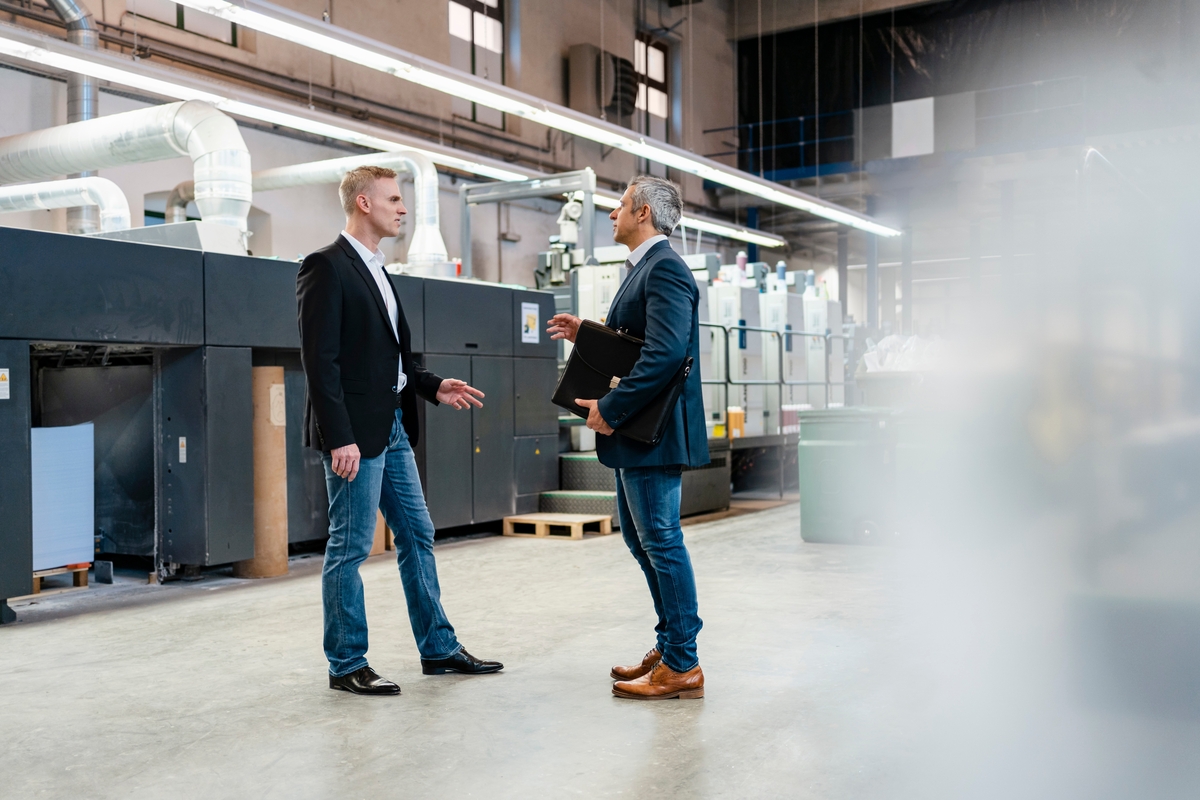
Your local professional can help you control temperatures inside your air compressor, boosting air compressor performance and compressed air system efficiency.
We work with a nationwide network of independent distributors, who can provide expert advice and support in setting up and operating your system to deal with high temperatures. In the long term, they can help you maintain and optimize your system, enhancing air compressor performance and compressed air system efficiency.
Key Takeaways
- Elevated outdoor temperatures can have a significant, negative impact on air compressor efficiency.
- The outside air you draw into your compressor brings outdoor temperature inside. If it’s 100°F outside, all that heat comes right into your unit.
- If your intake air is at 110°F, you will struggle to get the compressed air you send downstream below 120°-130°F.
- High compressed air temperatures will shorten the life of the oil and the compressor itself and increase all your costs. For every 10°F you operate the compressor above its normal operating temperature, the oil life is cut in half.
- Because oil-free units do not use oil as a cooling agent (although gear oil floods the jackets in the airend to help cool the discharge air and keep the housing temperatures lower), keeping them cool is even more challenging.
- There are several ways to get rid of that heat, including ventilation, forced air and water cooling.
- No matter which cooling methods you use, you’ll need to adopt good maintenance practices to keep your system functioning properly.
Let Us Help
Elevated outdoor temperatures have a negative impact on air compressor efficiency. And thus, keeping temperatures under control in your rotary screw air compressor is critical to the operation of your compressed air system and all the processes that rely on that system. If you need help dealing with high temperatures in your air compressor, get in touch with the experts at Kaishan. Contact us today.
Random stat or
customer quote
textXXtext
text

